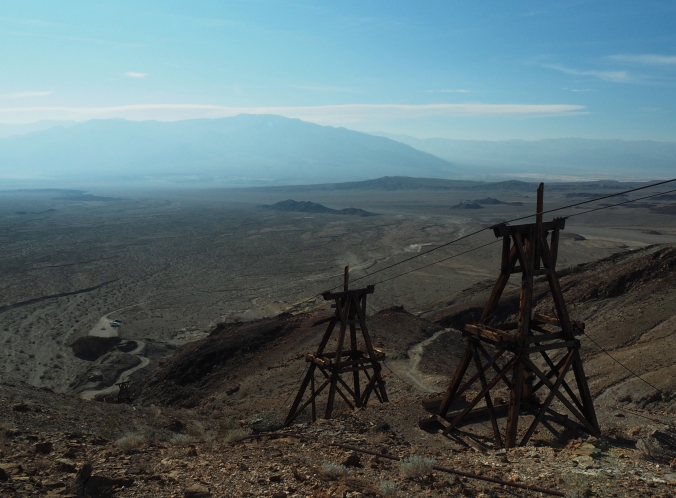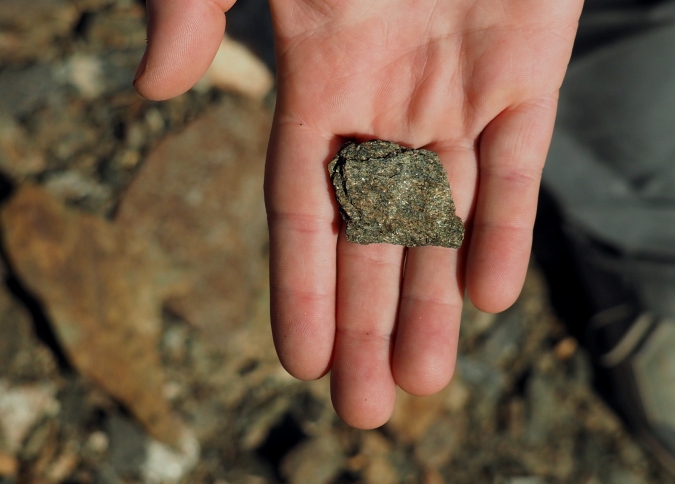Vastness. Miles and miles of uninterrupted wilderness. Places where wild animals call home and man is estranged. Such places are characteristic of the west coast, and for this reason, I will be forever drawn to this side of the country. These places exist partly because of the efforts that went into preserving our most treasured places. Also, though, the vastness of the west is due to the harsh conditions of its mountainous and desert regions; here, even with all of our modern technologies, it is still difficult to build on and to live in. Death Valley National Park is a prime example of such a huge, empty, and arid landscape.

Death Valley, California
In December, after celebrating my 30th birthday in Vegas, we had less than a week before we needed to be in L.A. to meet Stephanie’s dad and sister. Happy to return to California, we headed to Death Valley. A few days are not nearly long enough time to truly explore this vast landscape of desert dunes and mountains, but we saw as much as we could.
Having learned in Utah that backpacking in the desert is just about the most difficult thing one can do, we decided not to attempt such endeavors in Death Valley. Fortunately, however, backcountry camping in Death Valley does not require backpacking. With a free permit, one can camp in designated spots along backcountry roads. We chose different spots throughout the park and explored various areas by day hiking.
Wanting to explore some of the park’s dunes, the first night we camped near Saratoga Spring, located near Ibex Dunes in the southeasternmost corner of the park. Though the centrally located Mesquite Flat Dunes are more extensive, they are also more popular. We saw not a soul that night at camp. We spent the night in the FunBus and arose early to explore Ibex Dunes. We decided to walk to the dunes as they appeared close-by. The first time I ever saw dunes was in Oregon in 2010 with my friend Emma. At that time, we learned the hilarity and fun of combining the words “dude” and “dunes” in one sentence. “Dude, look at the dunes!” I said as we walked toward them. We walked and walked. And though we walked for what seemed to be at least a mile, the dunes never seemed to get any closer. The desert is a deceiving place.

Ibex Dunes – Death Valley National Park
When we finally reached them, we had a blast running up and over them, shouting, “Dunes, dude!” We tried not to tread anywhere that didn’t already have footprints. Though we knew the wind would eventually wipe away our tracks, we still wanted to uphold their pristine beauty as much as possible. Dunes are most beautiful when touched by nothing but the wind.

Dunes Dude – Death Valley National Park

Tracks in the Dunes – Death Valley National Park
Next, we drove up the Badwater Road, sad to leave our desolate site behind. We were shocked by the enormity of Death Valley. It took a long time to reach Badwater Basin, the lowest point in North America!

The conditions of Badwater Basin allow for the formation of salt flats. Salt flats are formed in dry climates, in basins where rainwater does not drain away. Due to the arid climate, water evaporates into salt and silt instead of forming into a lake. Still, walking out onto the salt flats looked like a lake froze-over. Closer inspection revealed the crystalized forms of salt!

Badwater Basin – Death Valley National Park
As it was on our route, we next drove along Artist’s drive: a one-way, single-lane drive through geologic formations. The highlight of the drive was Artist’s palette, which features different colored claystones.

Artist’s Palette – Death Valley National Park
Next, we drove south down the rough West Side Road to our new backcountry site. From the West Side Road, we turned into Trail Canyon on an even rougher road. Our permit specified that we could camp anywhere along Trail Canyon as long as it was a mile from the day-use road. At exactly a mile in, we found a decent place to pull off. Our spot was beautifully located in the middle of the basin, with the mountain ranges dominating our views to both the east and west.
In the morning, we drove first to Keane Wonder Mine: the most successful gold mine in Death Valley. Many structures and artifacts remain of this gold mining hub of circa 1900. We first explored the mine infrastructure at the bottom, then climbed up the slick footpaths that climbed above it.

Looking Over Keane Wonder Mine – Death Valley National Park
We soon came to the tramway structures, which we followed higher up. They were once used to transport gold to the mill where gold was extracted from ore. Though the history of this place was fascinating, I was most impressed with the amazing views at the top.

Tramway Structures – Keane Wonder Mine

View from Keane Wonder Mine – Death Valley National Park
Here, Stephanie found a rock speckled with gold flakes. We figured this could be a piece of ore containing a minimal amount gold. Perhaps the piece we found hadn’t had enough gold in it to be worth anyone’s time. Or perhaps we were completely wrong and it was just fool’s gold.

Prospecting – Death Valley National Park
After returning to the FunBus, we drove next to Mosaic Canyon. On the way, we drove by the Mesquite Sand Dunes. The overall expansiveness of them was impressive, though we noted the many foot tracks dotting each and every dune in sight. We were glad to have explored the virgin Ibex Dunes.
Though I’m not often a proponent of graffiti on trail signs, I was delighted by the graffiti on the backside of the Mosaic Canyon trail sign:

Mosaic Canyon was a fun hike. We had chosen it because it claimed the smallest width of any canyon in the park, but it certainly did not compare with the slot canyons of Utah! Still, we enjoyed scrambling through the canyon.

Mosaic Canyon – Death Valley National Park
At the end, we reached a spot that could only be passed by some technical climbing. Stephanie climbed to the top, but I chose not to. We turned around at that point.

Afraid of Scary Movies…
It was now time to head to our final campsite as we needed to be on the road to L.A. the following morning. On this night, we chose to stay at Emigrant, a developed primitive campground on the west side of the park. Being rather introverted, we were both disappointed at the proximity of campsites in this small campground. It was more or less a small dirt parking lot made up of 10 sites. As is often the case in such a situation, we ended up talking to most of our neighbors, and this time, we were glad we did! We met a most interesting fellow. He was just beginning a spectacular adventure of his own. He had recently arrived in California from New Zealand and was planning to motor bike his way through Mexico and South America. He started conversation with us by informing us that there was to be a meteor shower on this particular evening. We continued to talk to him from each of our respective campsites, until it became apparent that we should be friends, and we invited him to join us at our picnic table.
He turned out to be a doctor of neurology who worked at a university in New Zealand. He had recently recovered from a horrible back injury that had left him immobile for years, and was now taking this year-long trip as something of a celebration of his health. He gave us some interesting tips on how to take care of our brains. He told us what was good for our brains, such as repetition and novelty, explaining further that our spectacular journey is astronomically healthy for our brains because we are experiencing something novel every day; and also what was bad for our brains, such as drinking alcohol and smoking marijuana. This he explained as he passed the pipe and the whiskey bottle. Our new friend also taught us a new word. He was particularly fond of the trail mix we had been sharing with him. “That is excellent scroggin!” he exclaimed. “Scroggin?” we asked. “Yea, what do you call it?” Ever since, we’ve referred to this particular type of trail mix as scroggin. Though we were all tempted to stay up for the meteor showers, we were also all quite too old for such ventures. Sleep soon overtook our will.
In the morning, we said farewell to our new friend, wishing him well, and continued on our journey. Having spent big chunks of our days in Death Valley just driving across the massive landscape to our next destination, we saw so little of this mesmerizing place. In fact, we didn’t even enter the northern half of the park. Despite the shortness of our trip, I cannot forget the expansive views of this place. When I return to Minnesota and inevitably daydream about the west, I am certain that the vast and glorious landscape of Death Valley will appear in my head. To me, it defines what is so appealing about the west.
Fantastic photos. Death Valley is one I need to make it to still.
LikeLiked by 1 person